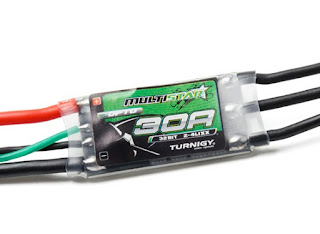Since I received my NAZA-M Lite and the F550 Frame, now it was time to select the other components to build the hexacopter, namely the Motors, Propellers, ESCs, and the Battery.
Now, if I have gone with the DJI ARF Kit, it would have included all the matching motors, props and ESCs. Since I opted to get the NAZA and the components separately, I needed to find a set of motors, ESCs and props which works with the NAZA-M Lite, and the F550 frame.
After some research online, I managed to come up with the following requirements for the components that would word with the NAZA and F550,
Motors:
2212 920KV - 3 pairs of CW and CCW (6 total)
These typically draw about 20 Amps of current.
Note: To learn what the numbers on a brushless motor mean, check out this guide.
Propellers:
8 x 4.5 or 10 x 3.8
It's recommended to use 8 x 4.5 if you're using a 3S battery, and 10 x 3.8 if it's a 4S battery.
To learn about propeller size numbers, check out this article.
Battery:
3S or 4S
Battery should be around 5000mAh to get a decent flight time with the F550 frame.
If it's a typical Li-Po, get one between 20C - 40C discharge rate. If it's one of the new LiHV type battery, then 10C or higher should be sufficient.
Higher C rating means the battery can give out more Amps, but it also means the battery would be bigger and heavier. So, balance it out.
ESCs:
Get 30A capable ESCs that work with 3S or 4S batteries.
Remember that the power the ESC can handle should always be higher than what the motor is capable of drawing. So, if your motors are rated 20A, then get 30A ESCs.
Also, get OPTO type ESCs, not the BEC type.
With these recommendations in mind, I started shopping around for the components.
At HobbyKing, I found the following items,
MultiStar 2212 CW/CCW Motor combo with 9 x 4.3 Propellers
This package has 2 motors - 1 CW, and 1 CCW - size 2212, with the propellers as well. The props are 9 x 4.3. But I think they should work with the F550.
Link to HobbyKing product page.
MultiStar 30A 2S-4S OPTO ESCs
Link to HobbyKing product page.
Multistar LiHV 5200mAh 4S 10C
This one was only 10C, but since it's LiHV, it should be sufficient.
Link to HobbyKing product page.
Unfortunately, HobbyKing does not ship Li-Pos to where I live. So, I'll have to find a compatible Li-Po locally.
I'm also going through local hobby shops to find more matching motors, ESCs, and props that work with the NAZA and F550. Will keep you updated.
Now, if I have gone with the DJI ARF Kit, it would have included all the matching motors, props and ESCs. Since I opted to get the NAZA and the components separately, I needed to find a set of motors, ESCs and props which works with the NAZA-M Lite, and the F550 frame.
After some research online, I managed to come up with the following requirements for the components that would word with the NAZA and F550,
Motors:
2212 920KV - 3 pairs of CW and CCW (6 total)
These typically draw about 20 Amps of current.
Note: To learn what the numbers on a brushless motor mean, check out this guide.
Propellers:
8 x 4.5 or 10 x 3.8
It's recommended to use 8 x 4.5 if you're using a 3S battery, and 10 x 3.8 if it's a 4S battery.
To learn about propeller size numbers, check out this article.
Battery:
3S or 4S
Battery should be around 5000mAh to get a decent flight time with the F550 frame.
If it's a typical Li-Po, get one between 20C - 40C discharge rate. If it's one of the new LiHV type battery, then 10C or higher should be sufficient.
Higher C rating means the battery can give out more Amps, but it also means the battery would be bigger and heavier. So, balance it out.
ESCs:
Get 30A capable ESCs that work with 3S or 4S batteries.
Remember that the power the ESC can handle should always be higher than what the motor is capable of drawing. So, if your motors are rated 20A, then get 30A ESCs.
Also, get OPTO type ESCs, not the BEC type.
With these recommendations in mind, I started shopping around for the components.
At HobbyKing, I found the following items,
MultiStar 2212 CW/CCW Motor combo with 9 x 4.3 Propellers
 |
| MultiStar 2212 CW/CCW Motor combo with 9 x 4.3 Propellers |
This package has 2 motors - 1 CW, and 1 CCW - size 2212, with the propellers as well. The props are 9 x 4.3. But I think they should work with the F550.
Link to HobbyKing product page.
MultiStar 30A 2S-4S OPTO ESCs
 |
| MultiStar 30A 2S-4S OPTO ESCs |
Multistar LiHV 5200mAh 4S 10C
 |
| Multistar LiHV 5200mAh 4S 10C |
This one was only 10C, but since it's LiHV, it should be sufficient.
Link to HobbyKing product page.
Unfortunately, HobbyKing does not ship Li-Pos to where I live. So, I'll have to find a compatible Li-Po locally.
I'm also going through local hobby shops to find more matching motors, ESCs, and props that work with the NAZA and F550. Will keep you updated.
Comments
Post a Comment